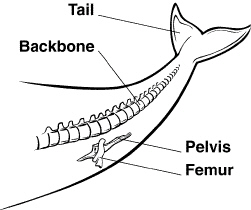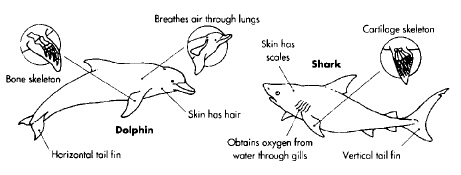Multiple Choice
Identify the choice
that best completes the statement or answers the question.
|
|
|
|
|
|
1
|
Refer to the illustration above. The bones labeled
A are known as
a) | sequential structures. | c) | homologous structures. | b) | fossil
structures. | d) | vestigial structures. |
|
|
|
2
|
Most male crickets produce a mating song by rubbing
together their curved wings. In a certain geographic area, parasitic flies detected male crickets
singing and deposited their larvae into them, which killed the crickets. Eighteen generations later
the number of males with flat wings has increased to 90%. The flat-winged crickets do not sing, but
are still able to mate with females, and parasitic flies cannot detect them. Which type of selection
is occurring in this cricket population?
a) | Artificial | c) | Stabilizing | b) | Directional | d) | Disruptive |
|
|
|
3
|
The wings of experimental fruit flies were clipped
short each generation for fifty generations. The fifty-first generation emerged with normal-length
wings. This observation would tend to disprove the theory of evolution based on
a) | survival of the fittest. | b) | inheritance of acquired characteristics. | c) | natural selection. | d) | inheritance of
mutations. |
|
|
|
4
|
The major idea that Darwin presented in his book
The Origin of Species was that
a) | giraffes and peppered moths changed
constantly. | b) | animals changed,
but plants remained the same. | c) | species changed
over time and never competed with each other. | d) | species changed
over time by natural selection. |
|
|
|

Figure 15-2
|
|
|
5
|
The pelvis and femur of the whale shown in Figure
15-2
a) | are acquired traits. | b) | allow the whale to walk. | c) | are vestigial
structures. | d) | are not
inherited. |
|
|
|
6
|
The hypothesis that evolution occurs at a slow,
constant rate is known as
a) | adaptation. | c) | natural selection. | b) | gradualism. | d) | slow motion. |
|
|
|
7
|
According to Darwin's theory of natural
selection, the individuals that tend to survive are those that have
a) | the smallest number of
offspring. | b) | characteristics
their parents acquired by use and disuse. | c) | undergone
mutations. | d) | variations best
suited to the environment. |
|
|
|
A Comparison of
Dolphins and Sharks

|
|
|
8
|
Refer to the illustration above. While the shark
and dolphin are similar in appearance, they evolved independently. This is an example
of
a) | convergent evolution. | c) | phenetics. | b) | cladistics. | d) | divergent
evolution. |
|
|
|
9
|
To compare the relative ages of fossils, scientists
use an easily recognized species called a(an)
a) | radioactive fossil. | b) | index fossil. | c) | carbon
fossil. | d) | sedimentary
fossil. |
|
|
|
10
|
Which is a major concept included in Lamarck's
theory of evolution?
a) | Sexual reproduction is the genetic basis for
variations. | b) | Selection
pressures decrease the rate of evolution. | c) | Body structure can
change according to the needs of the organism. | d) | Change is the
result of mutations. |
|
|
|
11
|
A change in the frequency of a particular gene in
one direction in a population is called
a) | chromosome drift. | c) | directional selection. | b) | acquired
variation. | d) | balancing selection. |
|
|
|
12
|
Populations are separated by barriers such as
rivers, mountains, or bodies of water in
a) | temporal isolation. | b) | behavioral isolation. | c) | natural
selection. | d) | geographic
isolation. |
|
|
|
13
|
Which of the following is a vestigial
structure?
a) | flower color | c) | fossil
cast | b) | the bill of a finch | d) | the human
tailbone |
|
|
|
14
|
According to fossil evidence, whales evolved from
4-legged ancestors. The modern baleen whale has forelimbs, but inspection of its skeleton reveals
only tiny vestigial hind limbs. What is the best explanation for this loss of hind limbs in the
baleen whale?
a) | Some whales lost longer hind limbs to predators and
passed that trait to their offspring. | c) | Random
chance and genetic drift led to the reduction in size of hind limbs. | b) | Whales with shorter hind limbs swam faster than those with longer hind
limbs. | d) | The hind limbs adapted into flippers to help the whale swim
faster. |
|
|
|
15
|
Dinosaur species dominated Earth for over 100
million years. During this time, most mammals were small mouse-sized nocturnal organisms. Following
the mass extinction of the dinosaurs, the small mammals rapidly diversified to fill available
habitats and niches. What pattern of evolution best explains the diversification of
mammals?
a) | Catastrophism | c) | Gradualism | b) | Convergent
evolution | d) | Punctuated equilibrium |
|